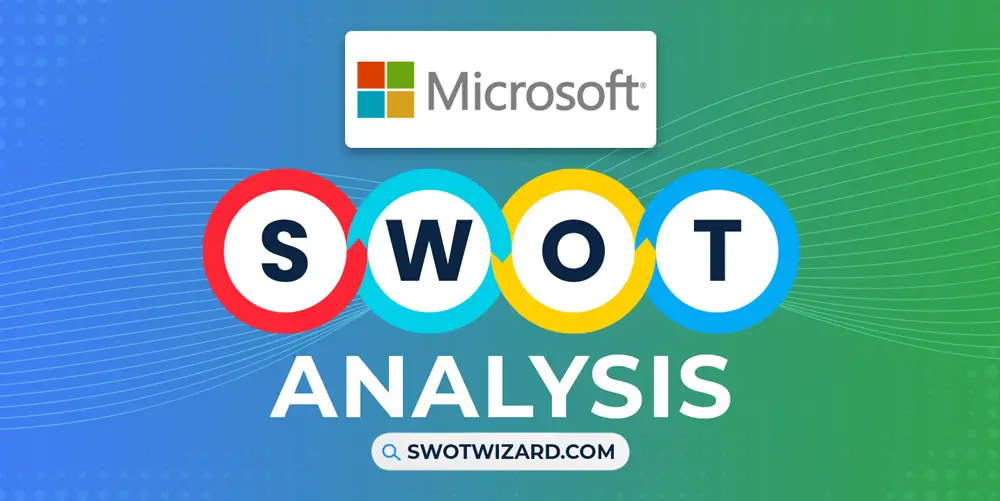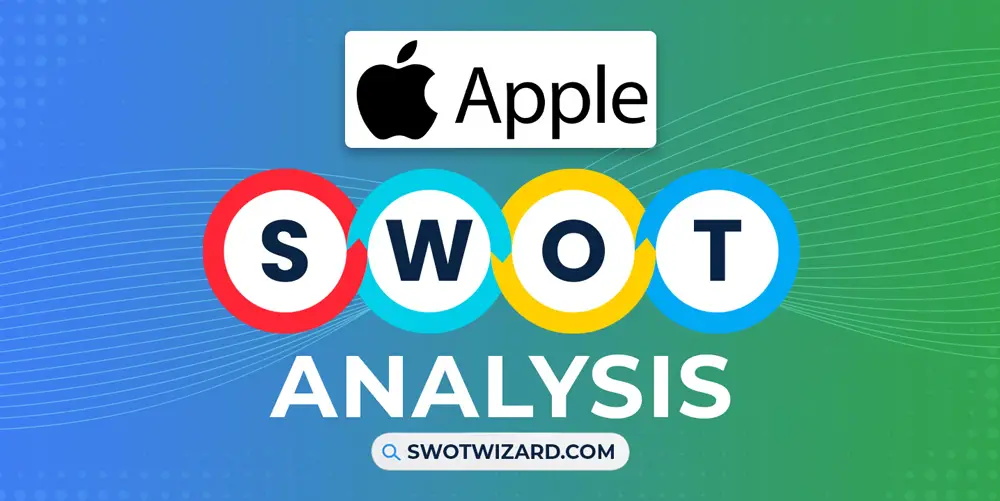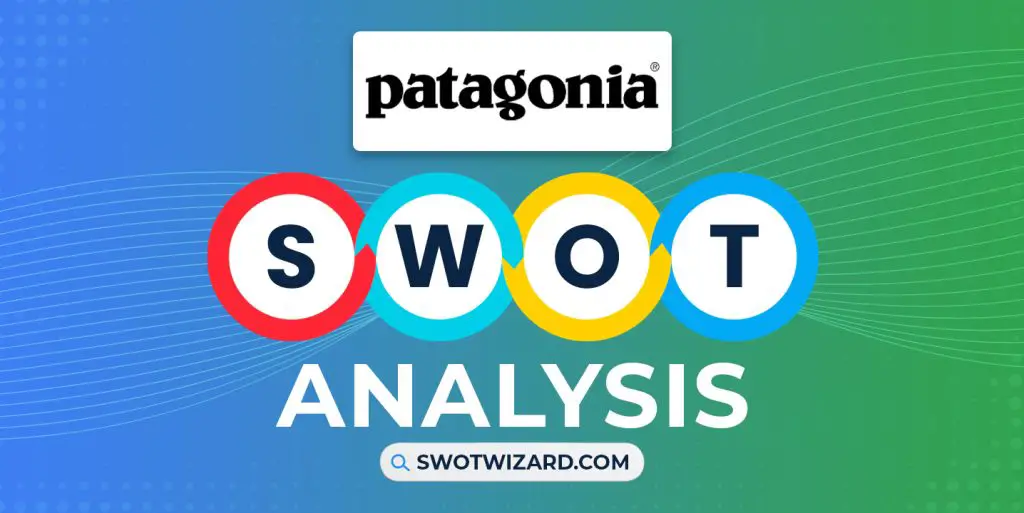Microsoft is the world’s 3rd largest company and the 2nd largest company by market cap. The company’s market cap in 2023 is at $1.676 trillion, with a $203.07 billion revenue in 2022. The company is one of the oldest tech giants. We will now get into the Microsoft SWOT analysis to understand how it has cornered the commercial software market so effortlessly.
Microsoft: Company Overview
| Company | Microsoft Corporation |
| Industry | Information Technology |
| Founded | 4 April, 1975 |
| Founder | Bill Gates, Paul Allen |
| Chairman & CEO | Satya Nadella |
| Headquarter | Washington, U.S. |
| No. of Employees | 221,000+ |
| Annual Revenue | $198.3 billion (FY 2022) |
| Website | microsoft.com |
On November 26, 1976, Paul Allen and Bill Gates registered Micro-Soft with the Secretary of State of New Mexico. The company dominated the market from the get-go, with Microsoft Basic in the late 1970s and Applesoft BASIC and Commodore BASIC in the late 1980s. The company introduced Windows 1.0 to the market on November 20, 1985.
Microsoft is now one of the monoliths that govern the global tech industry. It has the largest user base of all operating systems and a set of corporate software that practically has no competition. Despite not being the 1st company by market cap, it has a higher stock price than the top 2 at $224.93.
Product & Services of Microsoft Corporation
Windows | Microsoft Office | Bing | LinkedIn | Surface Pro | Microsoft Azure
Microsoft Competitors
Apple | Google | IBM | Samsung | Cisco | AWS | Oracle | Sony
Did You Know?
For their anniversary, Microsoft’s employees bring a pound of chocolate for each year of employment to celebrate. Traditionally, it’s a pound of M&Ms, but some employees like to break tradition and bring in other types.
Strengths – Microsoft SWOT Analysis
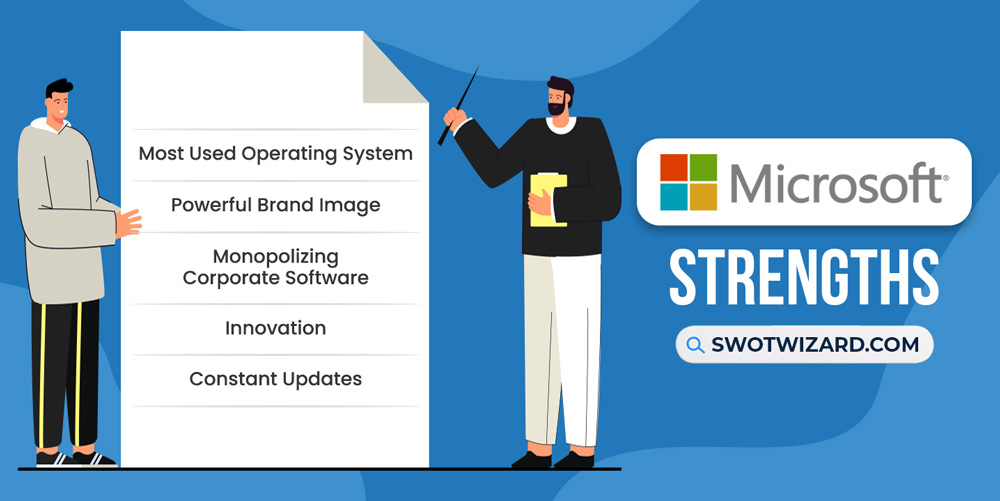
Most Used Operating System: Microsoft’s Windows platform has been predominantly the most used operating system in the world. Windows holds 70% of the global market share and 75% for desktops exclusively. In December 2022, Windows 10 had a 67.95% market share of the Windows platform, and its competition is Windows 11, at 16.97% market share. Right now, more than 1.4 billion devices are running either Windows 10 or 11 monthly.
Powerful Brand Image: Entering the tech market at its infantile stage and attempting to saturate the personal computer software market has provided Microsoft with a powerful brand image. While the company is not immediately recognizable, every computer user knows its products, such as Office, Windows, Xbox, Azure, Dynamics, LinkedIn, Bing, and Teams.
Monopolizing Corporate Software: Microsoft Office is a market-monopolizing set of software that has dominated the workplace since 1989. The Office package contains Word, Excel, PowerPoint, and more tools that have enabled record-keeping and word processing for the commercial world. Competitors such as Google and Apple have tried to invade the market, and open-source software such as LibreOffice and OpenOffice are free alternatives for users. Yet over 1.2 billion users continue to use Microsoft Office globally.
Innovation: Microsoft has used its vast resources to constantly innovate and create impactful software. It has used it’s used reinforcement learning AI to achieve a maximum score of 999,990 in Pac-Man. It’s made significant headway into quantum computing, deployed 137 AI-based projects to protect biomes, and used its Seeing AI to help blind or low-vision users with 20 million tasks.
Constant Updates: Despite cornering the operating system and commercial software market, Microsoft has never stopped updating its products. Microsoft has launched newer versions of the Windows operating system, with Windows 10 alone receiving over 40 updates. In Microsoft Office, Word has gained functions such as speech-to-text, PowerPoint can design slides automatically, and Excel can now create maps from data. Office 365 has made all these features available, with the ability to work anywhere, from any device.
Weaknesses – Microsoft SWOT Analysis
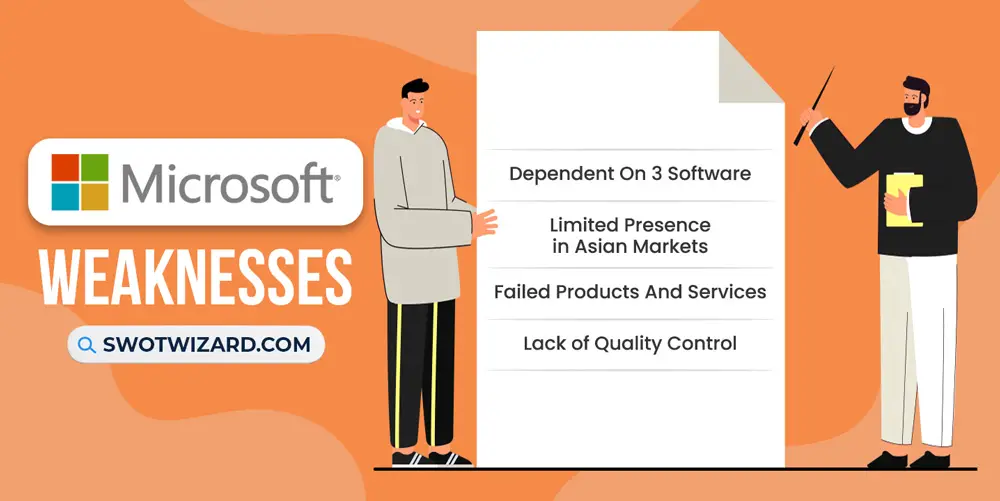
Dependent On 3 Software: Of all of Microsoft’s products and services, Azure, Windows, and Office are the most profitable. In 2022, Azure generated 34% of Microsoft’s revenue, Office generated 23%, and Windows 12%. Any other ventures undertaken by the company failed to exceed 9% of the revenue stream. These 3 software are Microsoft’s oldest offerings, which indicates the company has never successfully expanded into other markets.
Limited Presence in Asian Markets: Microsoft has had a long-running issue with invading Asian markets. Most Asian markets consider Microsoft products to be too expensive to buy and often resort to piracy or free, open-source variants. Markets such as China have announced Microsoft as a monopoly and either restricted its operations or launched domestic opposition.
Failed Products And Services: Microsoft has offered more than 100 products and services that have not taken off or have been dwarfed by competitors. For example, Xbox is outpaced by Sony’s PlayStation in the console market, Translator is unheard of thanks to Google Translate, and Cortana is ignored in favor of Apple’s Siri, Amazon’s Alexa, and Google Assistant.
Lack of Quality Control: Microsoft is known for pushing out updates and products that have critical issues. The official forums are teeming with complaints of computers crashing right after a Windows update. The company mostly focuses on creating new features for each update and then relies on its insider program for bug reporting and bug fixing. The company has also faced issues with its Surface lineup, including devices not charging, unresponsive touchscreens, no sound, disconnecting from Wi-Fi, slow operations, and more.
Opportunities – Microsoft SWOT Analysis

High Cloud Computing Demand: Cloud computing has become a market trend in the technology space. Remote working software has made corporate operations much easier, and many are opting for cloud computing with high storage and processing power instead of expensive servers or personal machines. Cloud gaming has also taken off greatly, giving Microsoft’s Azure and Project xCloud a wider customer base to aim for.
Focusing On Artistic Games: Microsoft has spent billions of dollars acquiring game development studios such as Activision Blizzard, 343 Industries, The Coalition, Mojang, Zenimax Media, Obsidian Entertainment, Undead Labs, and more. However, the company’s in-house game development studios, such as Moon Studios, have already produced revolutionary games like the Ori series. Microsoft can focus on creating art-forward games that require little to no graphics and make games that’ll stand up to the test of time.
AI-Powered Operations: Microsoft has been using AI on side projects such as networking, biome protection, and limit testing model creation. Microsoft can use AI to refine its searches on Bing, in-Windows search box, translations, and personalize search results better. It can also use AI for Cortana to ensure that it can understand voice commands better, provide exact search results, and learn to provide quick and compact answers.
Threats – Microsoft SWOT Analysis
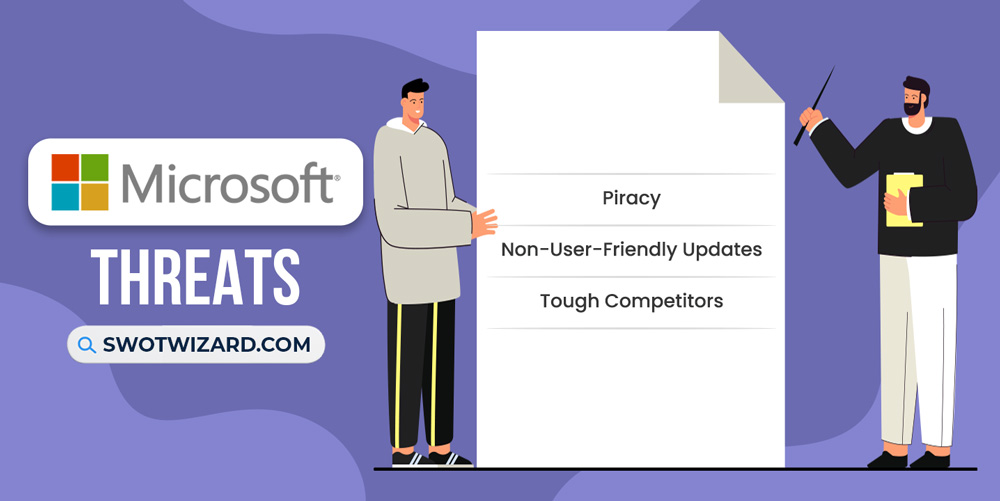
Piracy: Microsoft has been suffering from software piracy issues for nearly the entire length of its runtime. Asian markets, especially struggling markets, have resorted to using pirated copies of Windows and Office, causing the company to lose potentially billions in revenue. 91% of desktops in India, 90% in Indonesia, 73% in Taiwan, 55% in Singapore, and 43% in the Philippines come with pirated Windows and Office copies. If this spreads to other markets, the company won’t be able to profit.
Non-User-Friendly Updates: Microsoft is constantly focusing on innovation and adding new features to its products. However, the company can go too far and forget to make these changes user-friendly. The newest iteration of the Windows operating system has already been criticized for hardware restrictions, always online accounts, bloatware, forcing Edge use, and more. The next version can come with even more issues that can turn users away.
Tough Competitors: Tech giants such as Google and Apple have created alternatives for Windows, such as Chrome OS and Mac OS. Apple’s operating system has a high saturation rate for any Apple product user, thanks to the company’s ecosystem. Microsoft is also competing with open-source operating systems such as Ubuntu, and Pop! OS, Steam OS, and other Linux distros. Thanks to Linux becoming more gamer-friendly, Microsoft can see a mass exodus if it manages to upset its user base.
[Bonus Infographic] SWOT Analysis of Microsoft
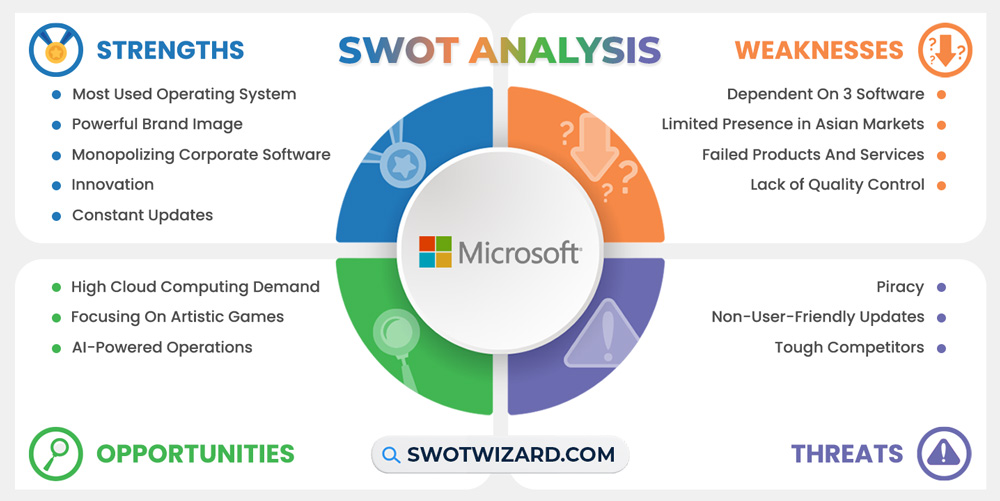
Recommendations for Microsoft Corporation
Microsoft doesn’t yet have to worry about being overtaken. But it can expect its market growth to be stunted and even reversed with the aggressive changes its competitors are making. To ensure its continued dominance and growth, the company can consider these changes.
- Microsoft should expend more resources on bug fixing. Instead of allowing an insider program to beta test new updates, it should have a dedicated team of developers rigorously testing the update before they launch it.
- The company should check if updates are necessary at all. Microsoft’s constant updates are appreciated but sometimes too frequent to matter. It can save a lot of resources by slowing down its update schedule and adding more value to each update.
- Microsoft should consider not increasing profitability by aggressively collecting and selling user data to marketing agencies. While this helps short-term profit margins and growth, the user base is growing infuriated by the privacy breach and looking for alternatives.
- The company should not gatekeep its version updates with hardware or software restrictions. This automatically lowers public interest and loses its revenue if the users don’t update.
- Microsoft should refrain from forcing online user-only accounts on Windows. This has caused many users to opt-out of using Windows 11 or go for pirated variants that allow offline accounts.
Frequently Asked Questions (FAQs)
How did Microsoft get its name?
Co-founder Paul Allen coined the name from “Micro-Soft BASIC”, a line they left in the source code of their 1st product.
How many document formats does Microsoft Word support?
Microsoft Word can support up to 22 document formats, including .odt, .pdf, .dotx, .docx, and so on.
Final Words on Microsoft SWOT Analysis
As a tech giant, Microsoft has introduced us to a completely new generation of computing. It’s empowered both corporate and personal lives with its operating systems and other software. However, it now needs to focus its attention on improving user experience and ease of use more than innovation and new functionality. Otherwise, it risks sending its user base to its competition.
References
- Wikipedia contributors. (n.d.). Microsoft Corporation. Wikipedia.
- Alsop, T. (2022, April 21). PCs – statistics & facts. Statista.
- Bellis, M. (2020, January 10). A Short History of Microsoft. ThoughtCo.
- Microsoft (MSFT) – Market capitalization. (n.d.). CompaniesMarketCap.
- Farrell, N. (2018, November 6). Microsoft fighting Asian pirates. Fud Zilla
- Franek, K. (n.d.). Microsoft Revenue Breakdown by Product, Segment and Country. KAMIL FRANEK.
- Haack, P. (2008, October 15). One Year At Microsoft. Haacked.
- Hassan, M. (2018, October 6). Microsoft Has A Software Quality Problem. Thurrott.
- Lacoma, T. (2017, May 1). 15 quick fixes for the Surface 3’s most common problems. Digital Trends.
- Taylor, P. (2022, July 27). Global market share held by operating systems for desktop PCs, from January 2013 to June 2022. Statista.
- Mohan, M. (2016, October 26). Over 101 Microsoft Products, Services, & Apps You Probably Don’t Know. Mahesh One.
- Learn from Microsoft’s struggle doing business in China. (2014, August 12). Market Me China®.
- Microsoft by the Numbers. (n.d.). Microsoft.
- AI Lab projects. (n.d.). Microsoft AI Lab.
- All Products. (n.d.). Microsoft.
- Windows 10 update history. (n.d.). Microsoft.
- Moraa, C. (2022, April 12). 5 realities that prove Windows 11 is not user friendly. Windows Report.
- Pascal, R. (2022, March 31). Xbox Closes Gap But Playstation Still More Popular – 57.54% Of Market Share. SafeBettingSites.
- Team, T. S. (2018, February 11). 15 cool features you should be using in Office and Microsoft 365. Sherweb.
- Over 1 billion people worldwide use a MS Office product or service. (2021, April 10). Financial Post.
- Desktop Windows Version Market Share Worldwide. (n.d.). StatCounter Global Stats.
- Stewart, S. (2022, January 10). Is Linux Good For Gaming? Linux vs Windows. GamingScan.
- A Brief History of Microsoft Windows. (2022, September 1). Lifewire.
- Colp, T. (2022, January 19). Every game and studio Microsoft now owns. Pcgamer.

